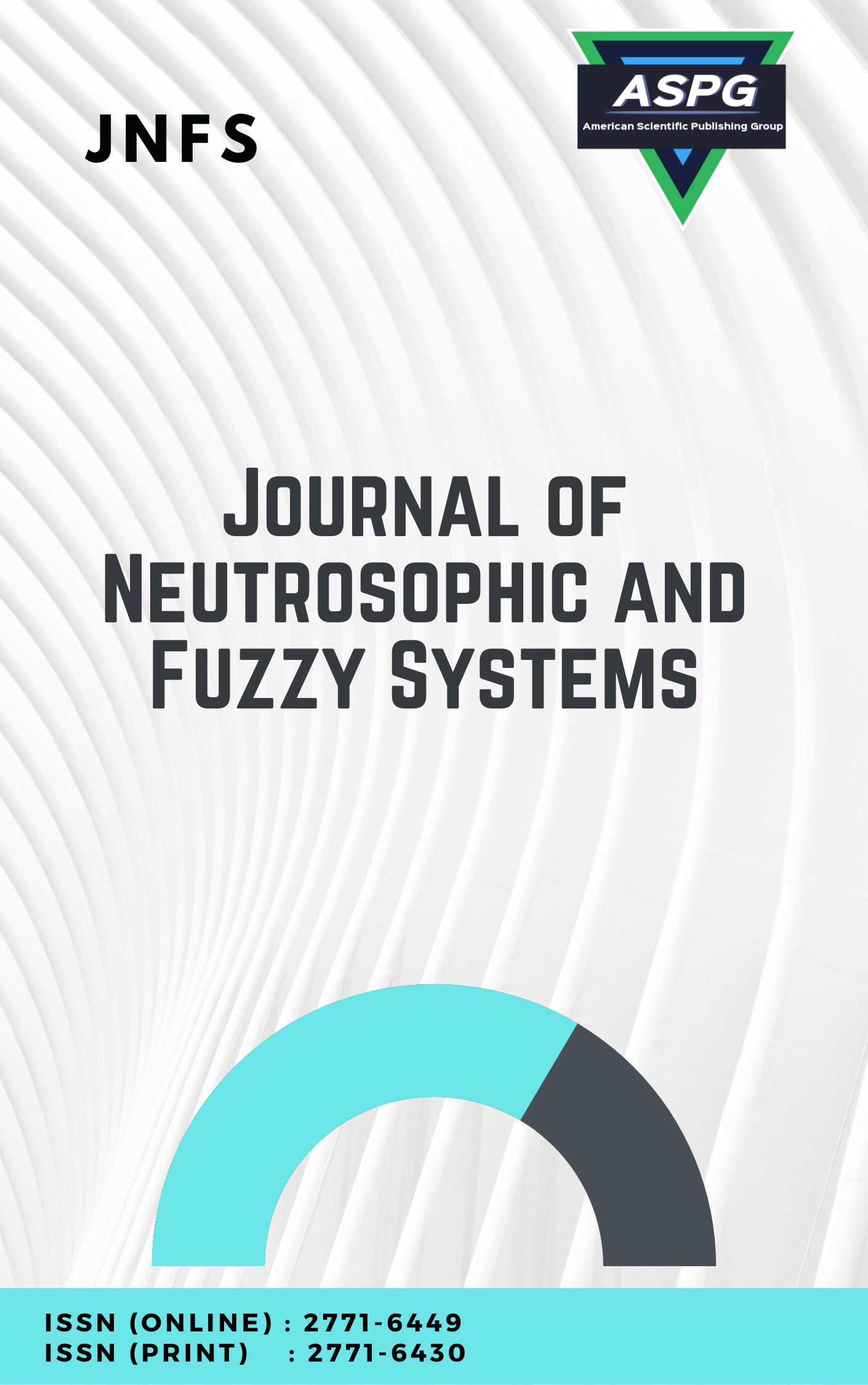

This paper is dedicated to study the concept of Fermat's triples in rings. Also, it determines the possible Fermat's triples in the neutrosophic ring of integers Z(I). Also, it discussed these triples in several finite commutative rings such as Zn.
Read MoreDoi: https://doi.org/10.54216/JNFS.010201
Vol. 1 Issue. 2 PP. 55-60, (2021)
In this paper, we introduce some new operators called neutrosophic δ frontier, neutrosophic δ border and neutrosophic δ exterior with the help of neutrosophic δ-open sets in neutrosophic topological space. Also, we discuss the important properties of them and the relations between them.
Read MoreDoi: https://doi.org/10.54216/JNFS.010202
Vol. 1 Issue. 2 PP. 61-70, (2021)
This paper solves the imperfect duplets problem in refined neutrosophic rings, where it presents the necessary and sufficient conditions for a pair to be an imperfect duplet in any refined neutrosophic ring. Also, this work introduces a full description of the structure of imperfect duplets in numerical refined neutrosophic rings such as refined neutrosophic ring of integers , refined neutrosophic ring of rationales , and refined neutrosophic ring or real numbers.
Read MoreDoi: https://doi.org/10.54216/JNFS.010203
Vol. 1 Issue. 2 PP. 71-79, (2021)
In this paper, we define for the first time the concept of symbolic Turiyam ring as a direct application of Turiyam symbolic set and as a new generalization of neutrosophic rings. Also, we study many of essential properties and related concepts of these rings such as AH-ideals and subrings. On the other hand, we illustrate many examples to clarify the validity of our work.
Read MoreDoi: https://doi.org/10.54216/JNFS.010204
Vol. 1 Issue. 2 PP. 80-88, (2021)
The Objective of this paper is to study the group of units problem in two different kinds of neutrosophic structures (neutrosophic rings and refined neutrosophic rings), where we use the concept of AH-isometry to classify neutrosophic rings\refined neutrosophic rings as direct products of classical rings with itself. Also, this classification will lead to the algebraic structure of the corresponding group of units.
Read MoreDoi: https://doi.org/10.54216/JNFS.010205
Vol. 1 Issue. 2 PP. 89-98, (2021)
The importance of studying the relationships between colleges, businesses, and governments has grown as a result of the recent explosion of technical advancements. The potential for national economic growth is enhanced by the dissemination of new information discovered via research. When it comes to the generation of new information that can be used by established economies, universities play a crucial role. So, in this study we proposed a framework for select best strategy in higher education. This process contains many conflicting criteria, so the concept of multi-criteria decision making (MCDM) is used. The MCDM is integrated with the triangular neutrosophic sets to overcome the vague information. The COCOSO technique is proposed to rank the alternatives. Higher education officials, including government bureaucrats and academic administrators, may put the recommended approach to use.
Read MoreDoi: https://doi.org/10.54216/JNFS.010206
Vol. 1 Issue. 2 PP. 99-106, (2021)
Multiple schools’ alternatives are assessed by experts based on a wide range of factors, therefore evaluating school performance may be seen as a multiple criteria decision-making (MCDM) issue. In this research, we developed a MABAC approach for evaluating MCDM education's effectiveness under interval-valued neutrosophic sets, keeping in mind the constraints posed by the assessment setting's complexity and the psychological behaviour of experts. Before everything else, experts' opinions are included in the calculation of criterion weights. Next, a novel assessment framework for assessing academic achievement in schools is developed using the MABAC model. Our research aims to provide educational institutions with the tools they need to operate at peak efficiency. In addition, other schools and allied educational institutions may use the study's findings as a benchmark in their assessments, attempts to improve performance, and formulation of educational policy.
Read MoreDoi: https://doi.org/10.54216/JNFS.010207
Vol. 1 Issue. 2 PP. 107-113, (2021)
The creation of decision-support techniques that can be used in the planned preservation and recertification ordering of healthcare facility investments is regarded as an assignment of extremely high difficulty due to the multitude of ambiguity and levels of individuality that is accessible in a decision-making procedure of this nature. This research employs a mixture of Neutrosophic logic and the Analytical Hierarchical Process (AHP) to generate a trustworthy score of hospital structure facilities depending on their varying levels of evaluation and achievement deficiencies. This is done to reduce the partiality that is related to expert-driven choices and to make the rankings more objective. This is additionally merged with the innovative use of machine learning techniques in this field, specifically: Random Forest, and Naive Bayes, to automate the process of setting priorities and making it reproducible, thereby reducing the essential for extra professional decisions.
Read MoreDoi: https://doi.org/10.54216/JNFS.010208
Vol. 1 Issue. 2 PP. 114-123, (2021)